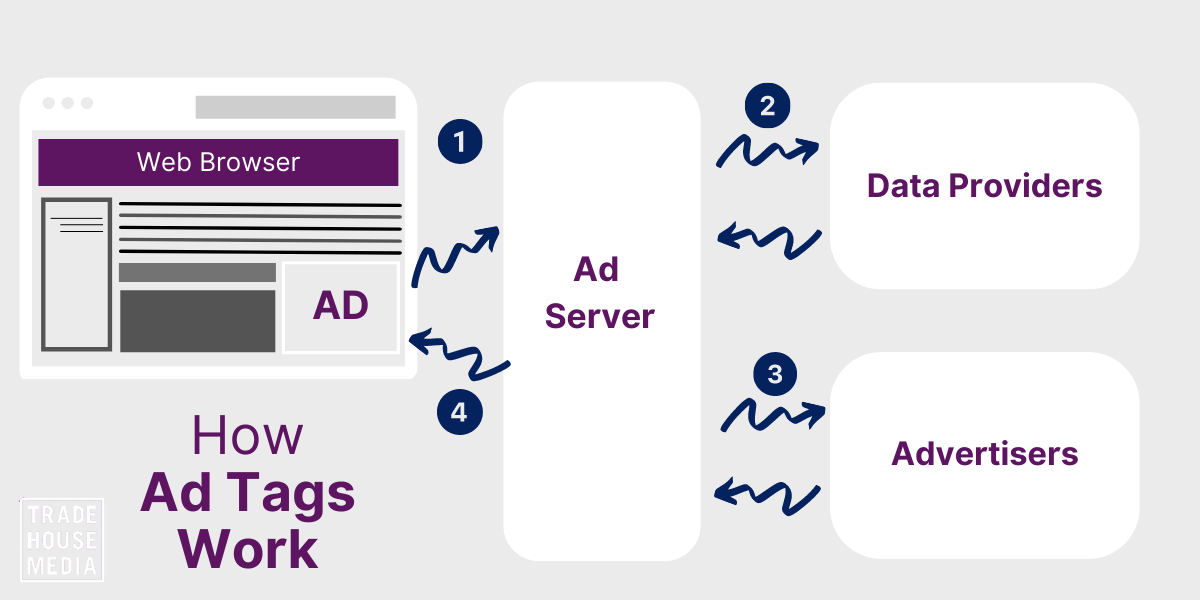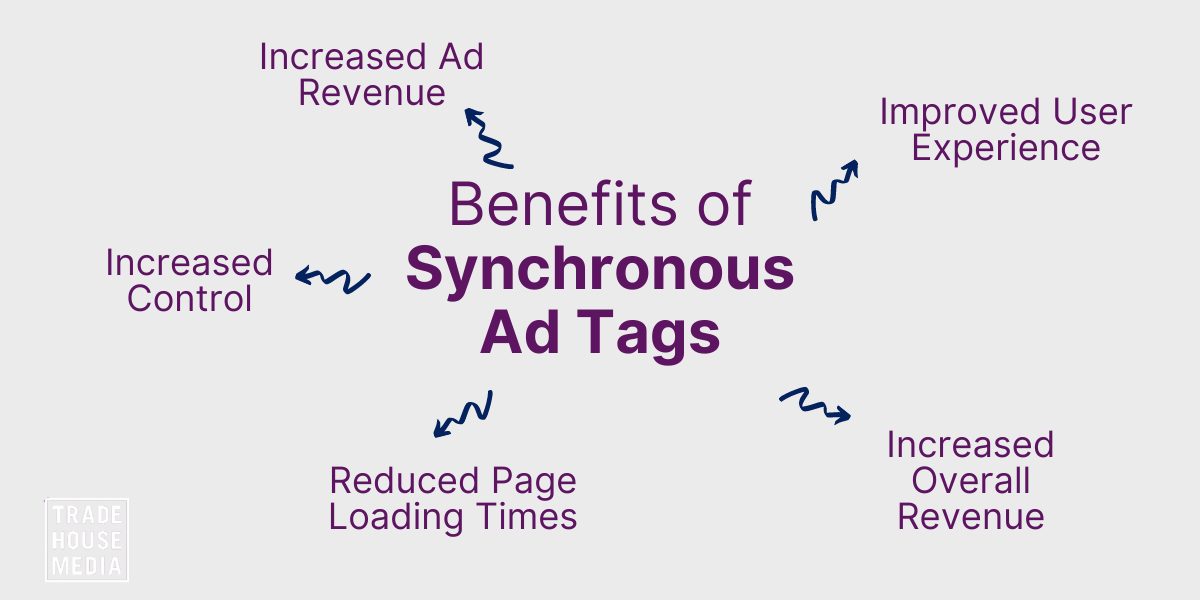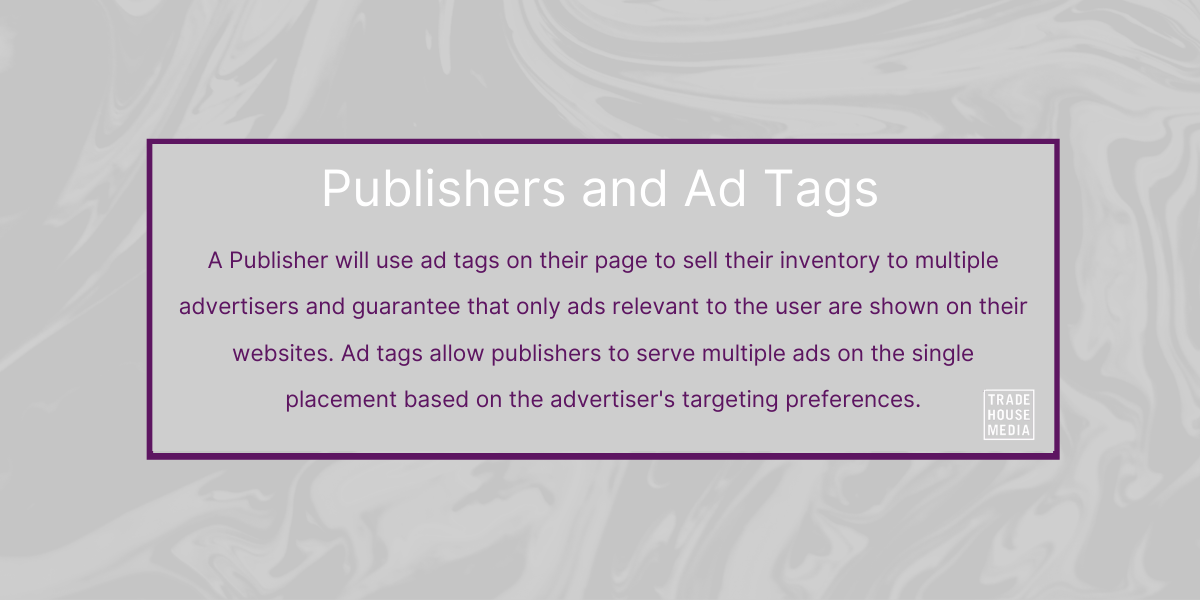An ad tag is a piece of code that is used to display advertising on a website. Ad tags are typically placed on websites by ad networks, which are companies that specialise in online advertising. Ad networks work with advertisers to place ads on websites and track the performance of those ads.
Ad tags come in different forms, but they all serve the same purpose: to deliver advertising content to website visitors. The most common type of ad tag is a JavaScript snippet, which is a small piece of code that is embedded into a web page. When a web page loads, the JavaScript code executes and fetches the ad content from the ad network’s servers.

What is an ad tag?
An ad tag is a small piece of code that is used to display advertisements on websites. Ad tags are typically provided by an advertising network or ad server, and they are used by web publishers to insert ads onto their pages.
Ad tags are usually embedded into the HTML code of a web page, and they can be used to display both static and dynamic ads. Static ads are simply images that are displayed on a page, while dynamic ads are usually more interactive and can include videos, games, or other rich media content.
Ad tags are used by both advertisers and publishers to manage their online advertising campaigns. Advertisers use ad tags to track the performance of their ads, while publishers use them to control where and how their ads are displayed. Ad tags can also be used to serves as a form of inventory control for publishers, by limiting the number of ads that are served on a particular page or site.
There are many different ad tagging solutions available, and they vary in terms of features and functionality. Some ad tagging solutions are more complex than others, and they may offer more granular control over ad delivery and reporting. However, all ad tagging solutions serve the same basic purpose: to help advertisers and publishers manage their online advertising campaigns.
What is the role of an ad tag in serving digital advertisements?
An ad tag is a snippet of code that is used to serve digital advertisements. Ad tags are typically placed on websites or apps by publishers, and they are used by ad networks to deliver the ads to consumers. Ad tags can be used to serve both display and video ads, and they play a vital role in the digital advertising ecosystem.
When a consumer views a website or app that contains an ad tag, the ad tag will contact the ad network and request an ad. The ad network will then serve the ad to the consumer through the ad tag. Ad tags play a crucial role in ensuring that ads are served to consumers in a timely and efficient manner. Without ad tags, digital advertising would not be possible.
What are the different types of ad tags?
Synchronous ad tag
A synchronous ad tag is an HTML code snippet that allows a web publisher to place an ad on their website. The code contains information about the ad, such as the size, weight, and placement on the page. This code is then read by an ad server, which serves the ad to the visitor’s browser.
Synchronous ads are generally considered to be more effective than traditional advertising because they are less intrusive and can be targeted to specific audiences. However, they can also slow down page loading times if not used correctly. For this reason, it’s important to choose a reputable ad server and to carefully test your code before implementing it on your site.
When used correctly, synchronous ad tags can be a powerful tool for increasing your website’s revenue. Here are some of the key benefits of using them:
- Increased ad revenue: Because synchronous ads are less intrusive and can be targeted to specific audiences, they tend to have higher click-through rates than traditional advertising. This means that you can potentially earn more revenue from your ad space.
- Improved User Experience: Synchronous ads can improve the user experience on your website by reducing page loading times and providing relevant, targeted ads.
- Increased Control: With synchronous ad tags, you have more control over the ads that are served on your website. This allows you to ensure that only appropriate ads are displayed to your visitors.
- Increased revenue: Synchronous ad tags can be a valuable tool for increasing your website’s revenue and improving the user experience. When used correctly, they can provide many benefits for both web publishers and visitors.
- Reduced Page Loading Times: When used properly, synchronous ad tags can actually reduce page loading times. This can generate more revenue per visitor by using synchronous ad tags.

Asynchronous ad tag:
An Asynchronous Ad Tag is a piece of code used by online advertisers to display ads on web pages. The code is placed in the web page’s HTML code and is executed when the page is loaded. The ad tag fetches the ad from the advertiser’s server and displays it on the page.
The advantage of using an Asynchronous Ad Tag is that it doesn’t slow down the loading of the web page, as the ad is fetched separately from the rest of the page content. This means that users can see the rest of the content on the page while the ad is loading, which improves the user experience.
If you’re an online advertiser, then using an Asynchronous Ad Tag can help improve your ad campaigns by making your ads more visible and user-friendly.
iframe vs. Javascript ad tags
There are two main types of ad tags – javascript and iframe. Javascript ad tags are more common, but iframe ad tags are also used. Here’s a quick overview of each type of ad tag:
Javascript ad tag:
- Usually embedded in the page code
- Loads faster compared to iframe tags
- Can be blocked by some ad blockers
iframe ad tag:
- Embedded in an HTML frame
- slower to load that javascript tags
- Generally not blocked by ad blockers
What is an iframe ad tag?
An iframe ad tag is a snippet of HTML code that allows you to insert an ad into your web page. Iframes are commonly used by advertisers to display ads on websites. When a user visits a webpage that contains an iframe ad tag, the advertiser’s ad server will deliver the ad to the user’s browser. The ad will then be displayed in the iframe on the web page.
Iframe ad tags can be used to display a variety of different types of ads, including text, image, and video ads. They can also be used to serve ads from multiple advertisers on the same page. This can be useful for publishers who want to monetise their website with advertising but don’t want to dedicate space on their page to a single advertiser.
If you’re a publisher looking to monetise your website with advertising, an iframe ad tag can be a useful tool for you. If you’re an advertiser, iframe ad tags can be a great way to reach your target audience. And if you’re just someone who’s curious about how advertising works on the web, hopefully this article has given you some insight into the world of iframe ad tags.
What is a javascript ad tag?
A Javascript Ad Tag is a piece of code that allows you to display ads on your website. There are many benefits to using a Javascript Ad Tag over other options, such as being able to track impressions and clicks, and having more control over the ad delivery. Additionally, using a Javascript Ad Tag can help reduce latency and improve page load times.
How do publishers use ad tags?
Publishers use ad tags to insert advertising into their webpages. Ad tags can be used to display a variety of ad types, including text, image, video, and rich media ads.
Ad tags are typically provided by ad networks or ad exchanges. Ad networks work with publishers to place ads on their websites. Ad exchanges act as a marketplace for buying and selling ad space.
Publishers can also create their own ad tags. This can be done using a variety of tools, including Google Publisher Tags and OpenX Ad Tags.
Creating your own ad tags gives you more control over where your ads are placed and how they are displayed. It can also help you optimise your ad revenue.

While ad tags are a helpful tool for publishers, they can also be used to track user data. Advertisers may use ad tags to collect information about users, such as their IP address and web browsing history. This information can then be used to target ads more effectively.
For this reason, it is important for publishers to be aware of how their ad tags are being used. You should consider whether you want to allow advertisers to collect this type of data on your website.
Ad tags can be a valuable tool for publishers. They can help you generate revenue and control where your ads are placed. However, you should be aware of how ad tags are used to track user data.
How do advertisers use ad tags?
Advertisers use ad tags to help deliver their ads to the right people, and to track the performance of their campaigns. Ad tags can be used to target ads by location, demographics, interests, or even specific website content.
They can also be used to track how many people see an ad, how long they stay on a page, and whether they click on the ad. This information helps advertisers fine-tune their campaigns and make sure they’re reaching their target audience.
So why do advertisers use ad tags? Ad tags offer a number of benefits that make them an essential tool for online advertising. Here are just a few:
They help deliver targeted ads: Ad tags can be used to target ads by location, demographics, interests, or even specific website content. This ensures that your ads are being seen by the people who are most likely to be interested in them.
They help track campaign performance: Ad tags can be used to track how many people see an ad, how long they stay on a page, and whether they click on the ad. This information helps advertisers fine-tune their campaigns and make sure they’re reaching their target audience.
They’re cost effective: Ad tags are a cost effective way to reach your target audience. They’re also a highly efficient way to track campaign performance so you can make adjustments as needed.
Ad tags offer a number of benefits that make them an essential tool for online advertising. By using ad tags, advertisers can deliver targeted ads, track campaign performance, and save money. Ad tags are a vital part of online advertising, and they’re here to stay.
How do ad networks use ad tags?
Ad networks use ad tags to deliver advertisements to websites and apps. Ad tags are snippets of code that are placed on webpages and apps. When a user visits a webpage or app, the ad tag calls out to the ad network, which then serves an ad to the user.
Ad tags can be used to target ads to specific users. For example, ad networks can use ad tags to show ads to users who have visited similar websites in the past, or who live in a certain geographic area. Ad tags can also be used to track how many times an ad has been shown, and how many people have clicked on it.
Ad networks use ad tags because they are an efficient way to deliver ads to a large number of people. Ad tags can be placed on websites and apps that receive a lot of traffic, and they can be used to target ads to specific groups of users. Ad networks also use ad tags to track the performance of their ads. By tracking how many times an ad is shown and how many people click on it, ad networks can optimise their campaigns to get the best results.

